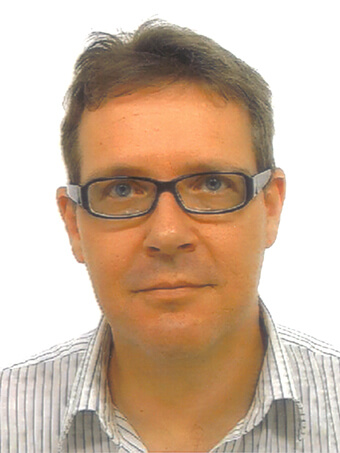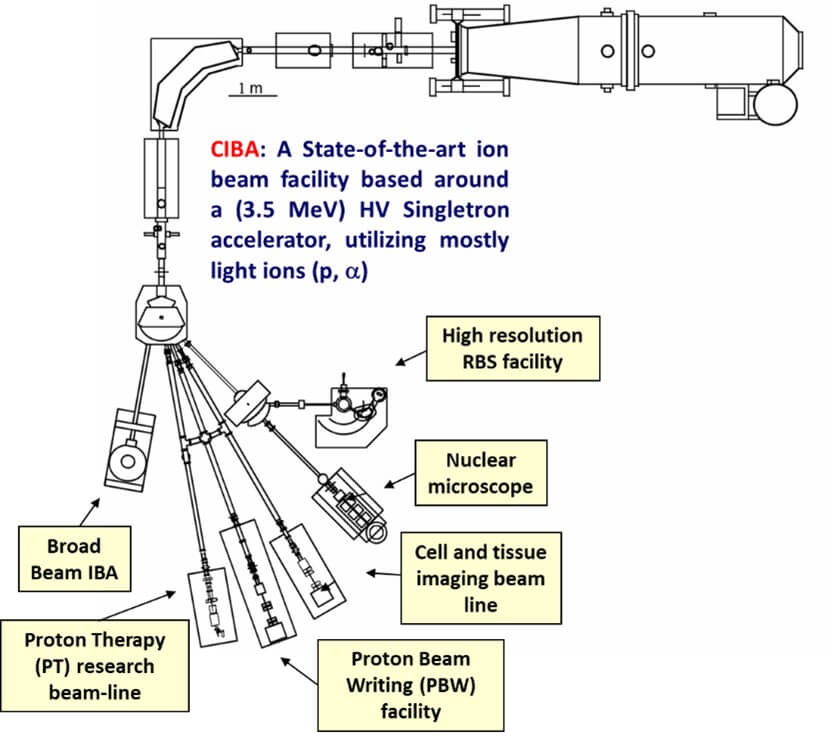
Thomas OSIPOWICZ
PhD, University of Gottingen, Germany (1990)
Associate Professor
Email: phyto@nus.edu.sg
Office: S12-03-10
Tel: +65 6516 6745
Current Research
- Application of ion-beam based techniques to a wide range of problems in materials science, life science and solid-state physics.
- Development of Nuclear Microscopy and the various analytical and lithographic techniques associated, e.g. ERDA, IBIC, RBS, Proton Beam Writing.
- Development and applications of high resolution (magnet spectrometer) RBS and ERD, quantitative techniques for the analysis of ultrathin film systems.
- Proton radiobiology for the further development of proton therapy modalities for cancer therapy.

CIBA is a multi-disciplinary research centre, we aim to develop new technologies based on fast protons and light ions (alphas, N ,O), and to undertake research into novel cutting edge ion-based applications.
- Currently, CIBA is the only accelerator group, globally, able to focus MeV protons to spot sizes below 20 nm. We are using this technology in a range of ongoing projects.
- In a collaboration with the National Cancer Centre, Singapore we explore ways to enhance the efficiacy of Proton Beam Therapy (PBT), the most advanced cancer radiotherapy available, which is rapidly being introduced in Singapore. CIBA groups operate two beamlines, one for in vitro single hit irradiation of sub-cellular structures, at resolutions below 500nm, and the other for rapid large area irradiation of millions of cells in a monolayer configuration.
- A wide range of applications of Ion Beam Analysis and Nuclear Microscopy research is ongoing at the dedicated beamlines at CIBA, as shown above.
Selected Publications
- Mi, Z. et al. Quantifying nanodiamonds biodistribution in whole cells with correlative iono-nanoscopy. Nature Communications 12, (2021).
- Ye, H. et al. Bright Photon Upconversion on Composite Organic Lanthanide Molecules Through Localized Thermal Radiation. The Journal of Physical Chemistry Letters (2017) doi:10.1021/acs.jpclett.7b02513.
- Zhang, X. et al. Lithiation-induced amorphization of Pd3P2S8 for highly efficient hydrogen evolution. Nature Catalysis 1, 460–468 (2018).
- Vajandar, S. K., Ren, M. Q., Zheng, D., Hsu, C.-Y. S. & Osipowicz, T. An optimized 19F (p, αγ)16O elemental mapping facility. Nuclear Instruments and Methods in Physics Research Section B: Beam Interactions with Materials and Atoms 461, 50–54 (2019).
- T.K. Chan, S.Y. Koh, V. Fang, A. Markwitz, and T. Osipowicz, “Loss of implanted heavy elements during annealing of ultra-shallow ion-implanted silicon: The complete picture”, Appl. Surf. Sci. 314, 322 (2014).
- V.R. D’Costa, L. Wang, W. Wang, S.L. Lim, T.K. Chan, L.H. Chua, T. Henry, W. Zou, C. Hatem, T.Osipowicz, E.S. Tok, and Y.-C. Yeo, “Towards simultaneous achievement of carrier activation and crystallinity in Ge and GeSn with heated phosphorus ion implantation: An optical study”, Appl. Phys. Lett. 105, 122108 (2014).
- Ren, M.-Q. et al. Quantitative analysis of multiple elements in healthy and remodeled epithelium from human upper airway mucosa using nuclear microscopy. Allergy 73, 724–727 (2018).
- T.K. Chan, F. Fang, A. Markwitz, and T. Osipowicz, “Solid phase epitaxy of ultra-shallow Sn implanted Si observed using high-resolution Rutherford backscattering spectrometry”, Appl. Phys. Lett. 101, (8) (2012), art. no. 081602
- U.B. Singh, D.C. Agarwal, S.A. Khan, S. Mohapatra, H. Amekura, D.P. Datta, A. Kumar, R.K. Choudhury, T.K. Chan, T. Osipowicz, and D.K. Avasthi, “Synthesis of embedded Au nanostructures by ion irradiation: influence of ion induced viscous flow and sputtering”, Beilstein J. Nanotechnol. 5, 105, DOI: 10.3762/bjnano.5.10 (2014).
